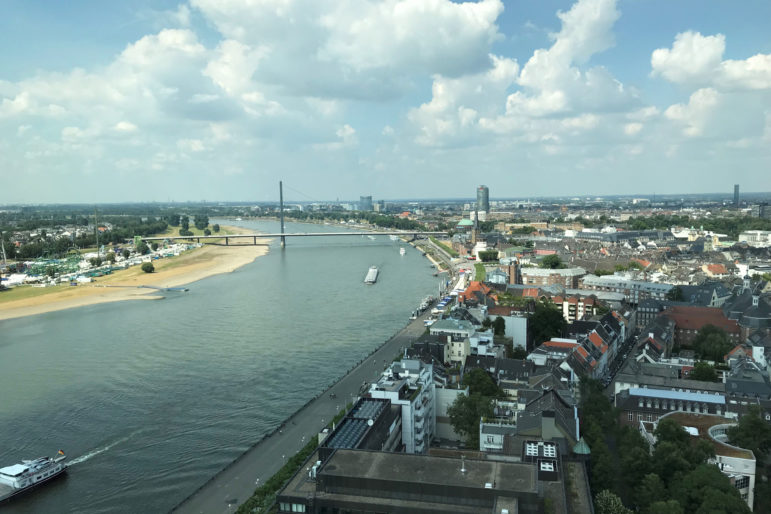
Germany is known as one of the first major economies to move off fossil fuels to clean energy through a program known as “Energiewende” (or “energy transition”) that began in the 1990s. This summer, Fresh Energy had the chance to see this progress first-hand through two trips as part of the Climate-Smart Municipalities partnership between Minnesota and the German state of North Rhine Westphalia and the Berlin Seminar on Energy Policy. Executive director Michael Noble spent a week in Berlin with other statewide policy leaders and director of public affairs Matt Privratsky spent a week in Dusselfdorf and other cities alongside local leaders from five communities across Minnesota.
Though each trip had a slightly different focus, it’s clear that Germany remains a key leader on clean energy and we gained information that we will be applying to Minnesota. It was also clear that Minnesota is now leading in some areas and there were some lessons we left behind for our German counterparts.
What we can learn from Germany
The biggest take away from both trips was the difference in tone between energy discussions in Minnesota and those Germany. Local, state, and federal officials across the political spectrum spoke about the need to address climate change as the core reasoning for their clean energy progress. That progress obviously comes with new jobs, lower prices, and a more resilient energy system overall, but for Germans of all political parties, climate action was the non-controversial root to their clean energy discussions.
In meeting with local officials, in particular, it also became very clear that while Germany has made global headlines for their progress on solar and renewables, their real edge is in creating buildings that are super-efficient—cutting waste and significantly reducing carbon emissions. Staff from the buildings team with the city of Muenster made this very clear when they created a hypothetical public building project and “built it” in both Minnesota and Germany. The version built to Muenster’s local building standards was so efficient that it was almost net zero (generating as much energy as it uses). Minnesota’s building was far less efficient. The German building had a higher up-front cost, but the operating costs were so incredibly low that the savings were immense. It’s clear we have a long way to go this area.
Lastly, the ambitious energy policies in Germany were matched by significant public investments. In clean transportation alone, the state of North Rhine Westphalia invests tens of millions of dollars to add charging stations and incentivize electric vehicles. Throughout Germany, they provide generous support for distributed solar systems to drive even greater private investments. Across the board, the government there put specific funding in place to support the policies that guide the market—a step not always taken in Minnesota.
What we left behind
For all the lessons we brought back with us, it was clear we left some behind as well. As Minnesota continues to work through our transition from aging power plants to a modern electric grid, we’ve focused our efforts on the most polluting units first knowing that other plants—such as carbon free nuclear plants—can serve as a critical bridge as wind, solar, and storage continue to strengthen the grid. In Germany, they have chosen to close their nuclear plants first. This, in turn, has kept coal burning plants up and running—and kept Germany from making meaningful progress on decarbonizing their electric sector. Choices like this involve dozens of factors—including hundreds or even thousands of jobs and the welfare of entire communities—but seeing such a stark contrast at such a dramatic scale did add some clarity.
And, for all the investments being made in clean energy across Germany, it was also clear that there was only a somewhat limited appreciation for the need to make those investments more equitable. Officials and staff were sometimes surprised to get questions from Minnesotans about how certain refund or incentive programs incorporated low-income customers or communities of color. Though Minnesota also has a long way to go to make our energy economy more equitable, Fresh Energy is proud to be pushing for more progress.
Lastly, it was clear that the strong role of government in shaping the energy economy meant there was sometimes less partnership with the private sector. While in Muenster with the Rochester delegation, we were able to see first-hand how innovative and forward thinking the Destination Medical Center model is and how much impact it can have as a broad public-private partnership. Rochester’s vision for a modern city with healthy transportation options, super-efficient buildings, and a truly vibrant community is buoyed by their extensive partnership with the Mayo Clinic and other local businesses. Local officials in Muenster are now eager to develop similar relationships with their local university and hospital.
Fresh Energy valued the chance to share insights with our German counterparts and build our collaborations with the communities on the trip—Duluth, Elk River, Morris, Rochester, and Warren. Stay tuned for how German lessons learned play out in our work and check out more information on the Climate-Smart Municipalities project.
